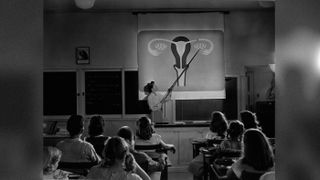Porn is the top source of 'sex education' for young adults
Pornography was the most-mentioned "helpful" source of information for 18- to 24-year-olds.

Young adults say pornography is their best source of information about how to have sex, new research finds.
In a nationally representative survey, a quarter of 18- to 24-year-olds listed porn as their "most helpful" source of information on how to have sex. This made porn the most-mentioned source of information, even above asking one's own partner.
The findings suggest a need for more education on healthy sexual relationships and on what pornography is about, said study leader Emily Rothman, a professor of community health sciences at the Boston University School of Public Health.
"Pornography is created to be entertainment," Rothman told Live Science. Pornography creators are focused on what's profitable, not what's instructional, she said: "It's fantasy."
Related: 5 ways porn affects the brain
Sex education
The proliferation of free streaming porn sites has made explicit content easier than ever to access, raising concerns about what, if any, impact pornography has on adolescents and young adults, Rothman said.
"There is concern from many different corners that increasingly young people are turning to pornography for information about how to have sex," Rothman said. She and her colleagues have been working for years on porn literacy instruction for teenagers. The concept behind porn literacy is not to shame people for being interested in pornography or to police the content they watch, she said. Rather, their trainings and courses aim to put pornography into context; to help young people understand why they might see content that doesn't represent healthy, consensual relationships; and to promote communication between sexual partners.
Sign up for the Live Science daily newsletter now
Get the world’s most fascinating discoveries delivered straight to your inbox.
"One of the problems we can run into with people taking their information from pornography instead of from their partner is, they could erroneously assume that certain sexual acts that they see on pornography are going to elicit a pleasurable response for their partner and try it without asking for consent," Rothman said. "And then we run into problems."
A recent content analysis, published in the journal Archives of Sexual Behavior, examined more than 4,000 videos on free streaming pornography sites. It found that between 35% and 45% contained depictions of violence, almost always toward women. While an interest in depictions of rough sex is not necessarily a problem in and of itself, Rothman said, these scenes rarely show the participants negotiating consent or taking other safety precautions, and thus shouldn't be used as an instruction manual.
The new study, published Jan. 4 in the journal Archives of Sexual Behavior, used data from the 2015 National Survey of Sexual Health and Behavior, a survey weighted to be nationally representative. In the survey, about half of participants said they hadn't received useful outside information on how to have sex. But the other half -- 357 young adults and 324 adolescents (ages 14 to 17) -- said they had.
Sources of information
Of those who said they had received helpful information, about a quarter of young adults put pornography at the top of the list, over sexual partners, friends, media and health care workers. Adolescents were much less likely to mention pornography, with only 8.4% turning to porn as their top source of information. Instead, the 14- to 17-year-olds were more likely to mention parents (31%) and friends (21.6%) as their top sources of information.
"The good news is, adolescents, in general, are listening to their parents," Rothman said. "It is worth it for parents to continue to have conversations with their adolescent children about sex. Your kids care about what you say."
The high proportion of young adults turning to pornography for information is more troubling, Rothman said. She and her colleagues are working to develop a Porn Literacy app for high-school sex education classes that educators can use to supplement their courses. Rothman's team has already developed specific porn literacy classes, available online and through the Boston Public Health Commission, but this information is rarely part of school-based sex education. Participants in the porn literacy classes are never shown pornography; instead, they discuss topics such as consent, body image and relationship violence. The app would expand the program's reach.
"We want to create this app that's like a self-guided tutorial that gives information about everything from sexually transmitted infections and communicating with their partner in a healthy way to myths and facts around porn so that at least young people are getting better information about what porn is and what it isn't, and doing it in a sex-positive way," Rothman said.
Originally published on Live Science.

Stephanie Pappas is a contributing writer for Live Science, covering topics ranging from geoscience to archaeology to the human brain and behavior. She was previously a senior writer for Live Science but is now a freelancer based in Denver, Colorado, and regularly contributes to Scientific American and The Monitor, the monthly magazine of the American Psychological Association. Stephanie received a bachelor's degree in psychology from the University of South Carolina and a graduate certificate in science communication from the University of California, Santa Cruz.
